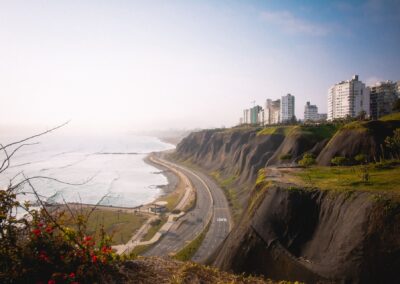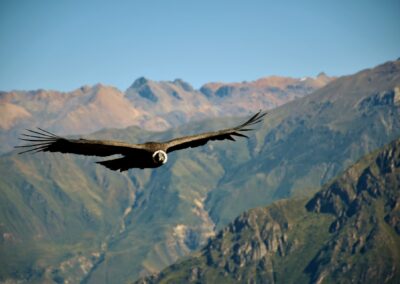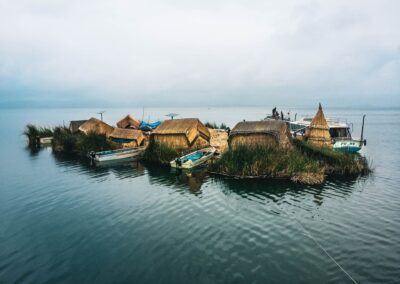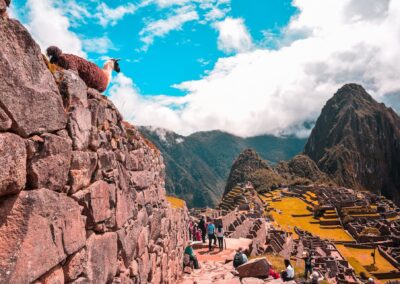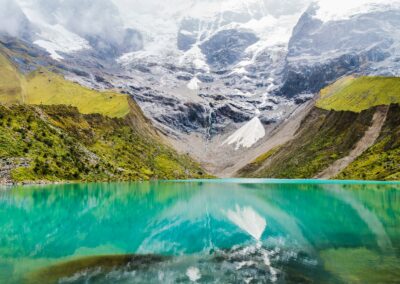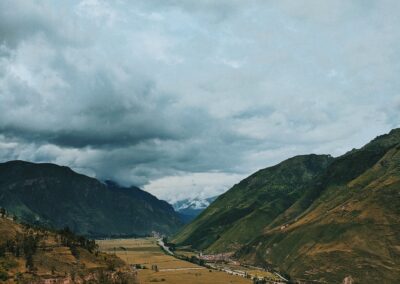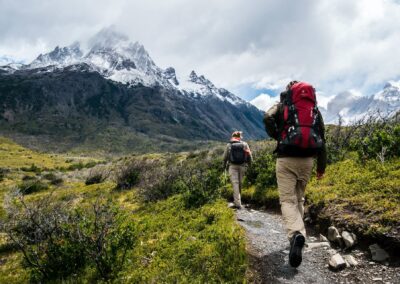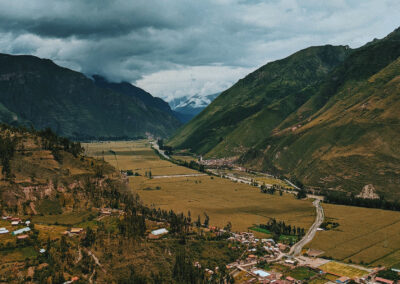Adventure in Cusco and Classic Inca Trail
13 Days / 12 Nights
ACTIVITIES
Hike, Camping, Zipline
DURATION
19 Days / 18 Nights
TIPO
Traditional
LOCATION
Lima, Nazca, Arequipa, Puno, Cusco
Introduction
The Peru Exclusive 19 days and 18 nights experience is a perfect balance of various adventures you can have on your visit to Peru allowing us to visit the main cities such as Lima, Ica, Arequipa, Puno and Cusco.
This experience is intended for all people who have an adequate and optimal state of health in the face of the necessary requirement, you can do it individually to be able to meet new people, as a couple or with friends with whom to share emotions and also as a family to live a unforgettable adventure.
Get inspired for your next vacation with testimonials from traveling customers like you!
Why book this tour?
Get to know the convent of San Francisco and its Catacombs in the City Tour of Lima.
Discover the mystery of the Pachacamac Sanctuary.
Visit the wonderful Ballestas Islands.
Discover the mysterious Nazca lines.
Experience the magical Andean cosmogony in the Colca Canyon.
Enjoy the relaxing hot springs in Chivay.
Take in the best views from the Cruz del Condor.
Enjoy the majestic flight of the condor and Vicuñas along the way.
Visit one of the deepest canyons in the world.
Meet the beauty of the church considered as the Sistine of America in Andahuaylillas.
Learn about the traditions and customs of the inhabitants of the natural island of Taquile.
Enjoy a magical night with local people on the island of Amantani.
Get to know the Basilica of the Cathedral and the Qoricancha in the City Tour.
Enjoy the flavors of Peruvian gastronomy in the Sacred Valley.
Surprise yourself with the circular terraces of Moray.
Surprise yourself with the beautiful Humantay lagoon.
Connect with the nature of the Mountain of Colors.
Experience thrills at the modern world wonder of Machu Picchu.
Capture the best shots from the House of the Guardian.
Discover the mystery behind the Intihuatana.
Fall in love with the Inca culture with its living history.
Summary Itinerary
Day 01: Welcome in Lima / Transfer to the hotel
- (At agreed time) Arrival of your international flight at Lima Airport and transfer to your hotel in Lima.
- Hotel night in Lima
Day 02: Pachacamac Sanctuary and Gastronomic Experience
- 09:00 – 10:30 Our excursion begins with a panoramic view of the "Pucllana Pyramid", built in the 4th century AD. and considered "sacred town" by the Incas.
- 12:30 – 14:30 We begin the visit to the traditional and bohemian district of Barranco, where its famous Bridge of Sighs stands out. We continue the tour through El Salto del Fraile, the Pantanos de Villa and we will enjoy spectacular views of the Pacific Ocean.
- The experience ends in Larcomar from there our workshop is 5 minutes away.
- 15:00 – 16:00 Welcome and start of the experience in the 4th level, we have 1 room where we will have an animated visit through the 3 regions of Peru.
- 15:00 – 16:00 Welcome and start of the experience in the 4th level, we have 1 room where we will have an animated visit through the 3 regions of Peru.
- Hotel night in Cusco
Day 03: City Tour in Lima and Magic Water Circuit
- 14:30 – 15:30 We visit the Historic Center of Lima, the museum of the central reserve bank, where you will appreciate the "Treasures of Peru Collection", a select exhibition of gold objects, ceramics and textiles from various pre-Columbian cultures.
- 15:30 – 17:30 Also appreciate the monumental complex of San Francisco, which constitutes the largest sample of colonial religious art in America. A visit to its underground crypts known as "Catacombs" stands out.
- 17:30 – 19:00 When we meet with our group we will begin with our tour ofmagic circuit of Waterto see the fabulous show of the sources that we found on the spot.
- 19:00 – 20:30 We go to our restaurant to enjoy a buffet dinner with a live show of music and dance.
- At the end we moved to our hotel.
- Hotel night in Lima
Day 04: Lima – Ica – Paracas
- 03:00 – 03:40 Pick up from your hotel and transfer to the bus station to start the experience towards Paracas.
- 07:45 Arrival in Paracas and immediate transfer to the pier of La Marina Turística.
- Excursion to the Paracas Peninsula, the most important wildlife sanctuary on the Peruvian Coast. Motor boat ride to the Ballestas Islands, in the Paracas National Reserve, where we can observe sea lions, booby birds, pelicans, penguins and other sea birds. On the way back we will have the opportunity to see the "Chandelier", a giant figure in the style of the Nazca Lines made in the sand. Free time before returning to take photos of the sea lions, seals and seabirds. Return.
- 10:50 Departure to the city of Ica in tourist mobility.
- 12:00 Arrival in Ica and transfer to start our tour.
City Tour Ica
- We will have the following visits: The Cathedral of the city of Ica, some wineries in the area and La Laguna de la Huacachina is a traditional place of rest for the people of Ica, the lagoon appears as an oasis in the middle of the desert, forming a splendid landscape of palm dunes and huarangos and continuing with the fun Buguis.
- Hotel night in Ica
Day 05: Paracas – Nazca Lines
- 09:05 Departure to the city of Nazca Cruz del Sur transport company.
- 11:15 Arrival to the city of Nazca and transfer to the aerodrome where we will have an introductory video of the Nazca Lines.
- *We will board a plane that will fly over the mysterious Nazca Lines; huge linear drawings of animals, birds and geometric figures, drawn in the desert, which can only be appreciated from the air.
- 16:00 Departure to the city of Lima by tourist bus.
- Hotel night in Lima
Day 06: Internal Flight: Lima – Arequipa
- (At agreed time) Transfer from the hotel to the airport (3 hours before).
- (At agreed time) Flight from Lima – Arequipa.
- (At agreed time) Reception at the Airport and transfer to the Hotel in Arequipa.
- Hotel night in Arequipa
Day 07: Colca Canyon (day 1)
- 08:00 – 11:00 Pick up from your hotel in Arequipa and we will start bordering the Chachani Volcano, passing through the Salinas Reserve and Aguada Blanca.
- Free time in Patahuasi to appreciate the beautiful high Andean landscape at the same time we can taste the Mate de Coca.
- 11:00 – 14:00 We continue through the Toccra area, in this area it is possible to find local flora and fauna. We will also have a prodigious view bordering the crater of the Chucura Volcano and free time at the Mirador de Los Andes.
- Upon arrival in Chivay we will go to our hotel to leave our luggage.
- 14:30 – 16:00 Free time for lunch in a tourist restaurant.
- Free time in the afternoon to visit the hot springs of La Calera.
- Hotel night in Chivay
Day 08: Colca Canyon (day 2)
- 08:00 – 10:00 Pick up from your hotel and transfer of our tourist transport, we will visit the Yanque town. Then we will continue our route to the Cruz del Cóndor viewpoint.
- Then we will continue the return route visiting the Altahuilque and Wayra Punku viewpoints, later we will make a stop in the town of Maca, a picturesque place with a cozy square that houses a baroque-style church from the 18th century.
- 10:00 – 12:00 return trip to Chivay.
- 12:00 – 14:00 Free time for lunch in a tourist restaurant.
- 14:00 – 17:00 Return trip from Chivay to the city of Arequipa.
- The bus leaves at 1:15 p.m.
- 13:20 – 15:00 We start our trip and we will have a short stop at the "Mirador de Patapampa".
- 15:30 – 17:00 Later we will make another stop at Patawasi, where we will have a snack and the traditional Coca mate, at this point we can also use the SS.HH. in addition to being able to buy handicrafts.
- 17:00 – 19:30 Our last stop is at "Lagunillas", at this viewpoint you have a panoramic view of the small lakes that seem to be mirrors reflecting the sky, it is also the habitat of Andean flamingos and other birds, without a doubt, a great opportunity to take photos.
- Upon arrival in the city of Puno, our transportation will be waiting for us so that we can go to our hotel.
- Hotel night in Puno
Day 09: Titicaca 2 days with overnight in Amantani (day 1)
- 06:45 – 07:00 Pick up from your hotel in Puno and transfer to the port.
- 07:00 -11:00 We board a boat to sail on Lake Titicaca, the first visit will be the Floating Islands of the Uros, we will learn about their history, how these islands were built on the highest navigable lake in the world.
- 11:00 – 17:00 Then we continue in our boat to reach the island of Amantaní, upon arrival our group will be divided among the families that welcome us, they will be the hosts responsible for giving them all the attention, accommodation, food during their stay.
- Night on the Island of Amantani (in a local family house).
Day 10: Titicaca 10 days with overnight in Amantani (day 2)
- 08:00 – 10:00 After our typical breakfast we will continue to the next island of Taquile.
- 10:00 – 12:00 Most of the people of Taquile are very cooperative and well organized. Life in Taquile is still largely traditional, untouched by modernity. 12:30 – 14:30 Free time to enjoy a delicious typical lunch.
- 14:30 – 16:00 Finally we will return in our boat to the port where our transport will wait for us to return to your hotel in Puno.
- Hotel night in Puno
Day 11: Tourist Bus Cusco – Puno (Sun Route)
- 06:30 – 06:45 Transfer from your hotel to the bus station (start of the tour).
- 07:00 – 17:30 Tour from Puno to Cusco by Bus with visits to tourist attractions along the route such as: Andahuaylillas Temple, Raqchi Archaeological Complex, La Raya Pass, Pucara Museum, etc.
- 17:30 Arrival in the city of Cusco and transfer to your Hotel.
- Hotel night in Cusco
Day 12: Cusco City Tour
- Hotel night in Cusco.
- 13:30 – 15:00 Visit to the Cathedral of Cusco and the Qoricancha or Temple of the Sun.
- 15:00 – 18:30 Tour of the main archaeological centers (Sacsayhuaman, Qenqo, Pucapucara and Tambomachay).
- Return to Cusco at approximately 6:30 p.m.
- Hotel night in Cusco
Day 13: Sacred Valley
- 08:00 – 08:30 Pick up from your hotel to start the Sacred Valley experience.
- 08:30 – 12:30 Free time at the Taray viewpoint, guided tour of the Pisac archaeological center and visit to the town of Pisac.
- 13:00 – 14:20 Buffet lunch at a tourist restaurant in Urubamba.
- 15:00 – 16:00 Guided tour of the archaeological center of Ollantaytambo.
- Free time to visit the town of Ollantaytambo on your own.
- 19:04 – 20:45 Travel by Train from Ollantaytambo to Aguas Calientes (EXPEDITION service).
- Hotel night in Aguas Calientes
Day 14: Machu Picchu
- 07:00 – 08:00 Bus ride from Aguas Calientes to Machu Picchu.
- 08:00 – 10:30 Guided tour of the main attractions within the Historic Sanctuary of Machu Picchu.
- At the end of the tour, return by bus to Aguas Calientes and have free time to have lunch at a tourist restaurant. (courtesy of the company).
- Hotel night in Aguas Calientes
Day 15: Visit to Machu Picchu and return to Cusco
- 08:53 – 10:52 Return train from Aguas Calientes to Ollantaytambo. (EXPEDITION service).
- 10:55 – 13:00 Travel by Van from Ollantaytambo to your hotel in Cusco.
- Free time in the afternoon to enjoy a visit to the streets of the city.
- Hotel night in Cusco
Day 16: Humantay Lagoon
- 04:00 – 04:30 Pick up from your hotel and transfer in tourist transport.
- 04:30 – 07:00 Travel from Cusco to Mollepata.
- 07:00 – 08:00 Tourist breakfast in a tourist restaurant.
- 09:00 – 12:00 Experience walking to the Humantay lagoon and prudent time to enjoy the landscape.
- 12:00 – 13:00 Return to our transport to go to the restaurant.
- 13:00 – 14:30 Buffet lunch in a tourist restaurant.
- 14:30 – 17:00 Return trip from Mollepata to Cusco.
- The end point in Cusco is at Plaza San Francisco at approximately 5:00 p.m.
- Hotel night in Cusco
Day 17: Maras Moray
- 08:00 – 08:30 Pick up from your hotel and transfer in tourist transport.
- 08:30 – 10:00 Trip from Cusco to Moray.
- 10:00 – 11:00 Visit to the circular terraces of Moray.
- 11:00 – 12:00 Visit to the natural salt flats of Maras.
- 12:30 – 13:30 Visit to the textile interpretation center in Chinchero.
- 13:30 – 14:30 Return trip from Chinchero to Cusco..
- The end point in Cusco is at Plaza San Francisco at approximately 2:30 p.m.
- Hotel night in Cusco
Day 18: Mountain of Colors
- 04:00 – 04:30 Pick up from your hotel and transfer in tourist transport.
- 04:30 – 07:00 Travel from Cusco to Cusipata.
- 07:00 – 08:00 Tourist breakfast in a tourist restaurant.
- 09:00 – 12:00 Experience walking to the Mountain of Colors and prudent time to enjoy the landscape.
- 12:00 – 13:00 Return to our transport to go to the restaurant.
- 13:00 – 14:30 Buffet lunch in a tourist restaurant.
- 14:30 – 17:00 Return trip from Cusipata to Cusco.
- The end point in Cusco is at Plaza San Francisco at approximately 5:00 p.m.
- Hotel night in Cusco
Day 19: Farewell to Cusco
- (At agreed time) Transfer from your hotel to Cusco airport 2 hours before your flight).
- (At an agreed time) Flight from Cusco – Lima
Detailed Itinerary
Our experience allows us to know the main places in the city of Cusco, enjoying the comfort in each space and the necessary security, the places that we will know are:
- Huaca Pucllana: It is an archaeological center site belonging to the local Lima culture, it is located in the district of Miraflores. It has been investigated and restored since 1981 by specialist Isabel Flores Espinoza. It is currently considered one of the main tourist assets. For its construction, adobe material and a little stone were used. Its structure has a pyramid 25 meters high and a set of patios, squares and enclosures. It has an exhibition hall, a circuit of visits and other attractions. Its extension has decreased over time since before, as its historical value was not considered much, some small pyramids were destroyed to be able to build houses, avenues and parks.
- Convent of San Francisco: SIt is located in the historic center of Lima. The facade very typical of its time has a baroque style with grace, details and stylized. A fine padding highlights its walls and in the upper part they are adorned with a wooden railing. Inside we can appreciate:
-
- Sacristy.
- Goal and Anteporteria.
- Cloister
- Chorus
- Dome
- Conventual archive and others.
One of the main attractions that we will find in this place are the Catacombs, which surprise most visitors because it was an old cemetery in colonial times. It was operational until 1810 and it is estimated that at that time it must have housed approximately 25,000 people. Today we can see in the different rooms quite a few bones classified by type and exhibited in an artistic way, such as those from the mass grave.
- Central Reserve Bank: It is a space where you can interact with art and with other visitors, because we can observe part of the great wealth that this place of origin of the various cultures of the past had. quite cozy in the way of a small hostel center, the museum welcomes you and welcomes you so you can take a break from your trip. The Central Museum's collection is a representative sample of Peruvian art of all times, from ancient times to the 21st century.
- Popular districts: We will get to visit the most iconic places such as the San Isidro district to visit the popular El Olivar park, then we will also visit the love park located on the Malecón, where we will have the best opportunity to have unforgettable and unique photos. Then we will also visit the district of Barranco where we will enjoy the popular Bridge of Sighs and its fantastic view of the Pacific Ocean.
- Magic Water Circuit: This wonderful destination has a total group of 13 interactive and intelligent water fountains where the combination of 3 factors: Water, Music and Light create images and laser effects, in perfect synchrony and harmony. Due to the beauty that this place possesses, in 2009 it won recognition as a Guinness World Record for having the highest group of fountains in the world. This place is popular with visitors from the country as well as from abroad and has become a symbol of the recovery of public spaces.
- Show dinner: Our gastronomic experience will be the best because of the wide variety that our restaurant offers us in terms of food, enjoying original and very famous dishes from Peru such as Lomo Saltado, Ají de Gallina, Ceviche and others. So also delicious and representative drinks such as Pisco Sour and Chicha Morada. Together with this delicious experience that will satisfy our appetite, we will be able to enjoy Creole music and dances representing the regions.
- Pachacamac Sanctuary: This sanctuary bears his name in Quechua, which translated would mean Soul of the Earth. At one point his cult grew significantly since the devotion was broader and people required special preparation to be able to enter as fasts that could last many months, it was also forbidden to directly observe the priests who resided in this place, to ensure this these priests entered from behind. We found different buildings and patios in the place, naturally only the high priests entered the largest temples, but the visitors of the town could observe and make their own sacrifices in the patios. It is known that the deity of Pachacamac was the center of all the religion of this region.
- Peruvian Pisco: Peruvian pisco is made from a select variety of grapes called pisco grapes that are grown in certain cities on the Peruvian coast such as: Lima, Ica, Arequipa, Moquegua and Tacna. This liquor delicacy caused a dispute to be generated between Peru and Chile for the property of origin, however its elaboration is different. Its origin dates back to the arrival of the Spaniards on the Peruvian coast in the 16th century, accidentally produced from grapes that were not used for wine production. In the most important varieties of Pisco we have:
- Pure Pisco
- Acholado Pisco
- Mosto Verde Pisco
- Aromatic Pisco
Of these varieties, the favorites for the elaboration of the Pisco Sour are the Pisco Puro and the Pisco Acholado for the essence that it has allowing this cocktail to be so recognized and delicious.
- Ceviche: Nowadays it is known as the flagship dish of Peru for its exquisiteness and its particular flavor. It is not known exactly what the beginnings of the ceviche were, but it is believed that many of the cultures that inhabited the Peruvian coast, such as the Mochica culture, prepared a dish based on fresh fish, which was combined with the juice of a fruit called Tumbo; Over time, the Incas adapted it for themselves by combining fish with chicha and it was until the arrival of the Spaniards that the ingredients that we know today in ceviche were added: lemon and onion.
- Ballestas Islands: They are a group of islands near the city of Pisco. They are formed by rocky agglomerations and it is considered a protected natural ecosystem where there is a significant amount of marine fauna cwith sea lions, fish and others as well as the presence of guano birds. This ecosystem as such is a place currently protected by the entity in charge, which is SERNANP. In order to visit it, it is necessary to use a yacht from the port of Paracas.
- Nazca Lines: They are ancient geoglyphs that are found in the Jumana pampas, in the Nazca desert, in the department of Ica located on the maritime coast. They were made by the Nazca culture and are made up of several hundred figures that range from designs as simple as complex zoomorphic figures (animal figures), phytomorphic figures (Plants) and geometric figures that appear traced on the earth's surface. Since 1994, the UNESCO organization has registered The lines and geoglyphs of Nazca as a World Heritage Site due to its importance. but due to the construction of the Pan-American Highway these have suffered some imperfections.
- The Basilica of the Cathedral of Cusco: It is located in the main square of the city, it is a colonial archaeological monument of great artistic and historical value, it was built on the Kiswar Kancha site, which was the place of residence of the 8th Inca ruler, the Inca Viracocha. The Temple of the Holy Family and the Temple of El Triunfo were also built on this same Inca site. Inside you can see the carved wood works such as the Choir, the Pulpit and the Altars, in the same way beautiful paintings of the Cusco school and works in embossed silver.
- Patapampa: On the way to Chivay this is one of the main viewpoints that we will find, here we can have a privileged view of the most important and imposing snow-capped mountains such as Walka Walka, Sabancaya and Ampato. As a tradition of the elevated places here you can also see mounds of rocks superimposed one on another located throughout almost the entire place. They also bear the name of Apachetas, it is said that they were made to pay tribute to the Apus or Sacred mountains. Here the inhabitants of the area are few and their main activity is the raising of camelids such as the vicuña and alpaca, as well as the occasional sale of their textile products made from these.
- Chivay: Its name is original from the Quechua term that when translated means clay plate because of the shape of the town. It has a history of Spanish foundation at the time of Viceroy Toledo, it was created to reduce the original peoples in order to subdue and educate them in the Catholic faith and thus be able to dominate them more easily. It is located on the western slope of the Andes Mountain Range, in the upper area of the Colca Canyon. The town is divided into 3: Urinsaya, Hanasaya and Ccapa.
- Calera thermal baths: This is an amazing attraction that we find very close to the town of Chivay, in the place we will find a set of heated pools built especially to keep the waters warm. These come from the Cotallaulli volcano, where they initially have a much higher temperature between 80° and 85°, but upon reaching Calera along the route, their temperature drops significantly to 38°, which makes it an ideal temperature for travelers who visit it, within the minerals that are in the waters we find Calcium, Zinc and Iron which makes these are considered as curative of various ills, such as rheumatism and many others related to the muscles and the skin because these are absorbed by the pores.
- Condor Cross: This place offers us a natural spectacle due to the height at which it is located. It bears this name because a large cross and a small stone wall were built in the place for the comfort of tourists as a form of security. At midday we will have one of the most important and beautiful events in this place, the Condor flies over the canyon and in reality this bird does not flap its wings, it only glides, so the show is wonderful. The condors gain altitude before gliding on the air currents that head towards the coast, where they find food.
- Yanque: It is a town full of living culture where people celebrate with Andean music and typical costumes, with a colonial church with pieces of art and painting that are unique for their details and finishes. In the place we will also visit the artisan center in which the artisans use ancient techniques to create the art of the Colca Valley.
- The Church of Andahuaylillas: Known as the Sistine Chapel of America due to its artistic finishes. It is a colonial construction that has a simple structure and on the front we find 3 crosses carved in stone, the interior is made of thick adobe walls. The richness of this church is found in its interior, as it has original works such as the penta-linguistic door and its works are originals by artists from Cusco.
- The archaeological group of Raqchi: A very important construction belonging to the Inca Culture in which they stand out: the immense temple of the God Wiracocha, the Qolqas that were used to store food, the Inca baths and the different constructions of Inca houses. Of course, Raqchi is the most important place to see and buy the beautiful Inca and colonial pottery. Find out more in our article on colonial Cusco pottery. After the visit, we will continue the trip towards the Sicuani district which is surrounded by beautiful landscapes. Here we will enjoy a typical buffet lunch in a tourist restaurant, then we will continue and make a stop at La Raya, we will get off the bus to breathe the fresh air of the place and take beautiful pictures with the llamas and alpacas that inhabit the place.
- Pukara: Which is located near the city of Puno. Here the famous "pukara bulls" are made, which by tradition are hung on the doors of houses as a good luck charm. The Pukara were a very important culture in pre-Inca times as they had knowledge of engineering, hydraulics and architecture. In the museum you can see ceramic objects and stone pieces of great value.
- Artificial island of Uros: The name has a meaning that the inhabitants of the place have chosen as men of water since, like few civilizations in the world, they live in aquatic space. the people who live here they are amazing and unique in the world because they build their own islands taking advantage of a type of plant that grows in the lake, called totora. Their origins are somewhat uncertain but those who studied them indicate that their history is prior to the Inca era and that when this culture emerged they were advancing proportionally until they conquered all the land spaces, for this reason they were forced to adapt to living in the water that gave them the necessary security and easy access to their main resource, which is fishing.
- Natural Island of Taquile: It is located on Lake Titicaca at a distance of approximately 3 hours from the city of Puno. Each person who arrives on this island can notice that although this destination is considered a tourist destination, it has not been modified or altered, so the lifestyle that people have is the traditional one like their ancestors. With an approximate population of 2,000 inhabitants, the main town is at an altitude of 3,950 meters above sea level and the highest point on the island reaches 4,050 msnm.
- Amantani Island: This is another of the largest natural islands that we can find within Lake Titicaca. Here the main activities that we can meet are agriculture, textiles and stone work. Its population is segmented into ten communities that cooperate with each other for maintenance and general well-being. The production on the island is based on tubers such as potatoes and oca, as well as corn, quinoa and certain vegetables such as beans and peas. On the other hand, among its natural attractions, it has two viewpoints to appreciate Lake Titicaca in all its extension. We will also find ceremonial centers of Pachatata and Pachamama to which the inhabitants today still worship out of respect. This island is the ideal one to be able to spend the night comfortably and have an experiential adventure with stories, traditions, gastronomy.
- The Qoricancha Temple: It was the most important religious center within the city built to worship the Sun (the most important Deity in the time of the Incas) and other deities (Stars, Rainbows, Lightning and Moon). On the foundations of the Qoricancha, the Santo Domingo temple was built and it also has beautiful paintings from the Cusco school in its colonial art gallery.
- Sacsayhuaman: It was built using large stones, joined with amazing precision simulating a puzzle, for a long time it was considered a fortress due to the height of its walls, however current studies consider it to be a multifunctional center since it has a storage sector and also religious. We will also enjoy the wonderful viewpoint that we have in the place to see the city. At present, the Inti Raymi festival is held in this place.
- Qenqo (Labyrinth): Considered as an Inca ceremonial center. An open space called an amphitheater stands out where its idols and mummies were found in the 19 trapezoidal niches it has, although it is currently up to half its true height due to the passage of time.
- Puka pukara: It has a name in Quechua that means the red fortress, the reddish color that it shows is due to the large amount of iron that its stones contain, it is deduced that the place was an old tambo that served as a rest and also to guard, according to some records. this place is probably the original Tambomachay since this place has a small cave.
- Tambomachay: This archaeological complex is made up of a set of finely carved stones, waterfalls and aqueducts from nearby fountains and springs, which is why it is related to the cult of water and for this reason the original name of the place is probably Quinua Puquio which refers to the worship of Water.
- Pisac: Its name refers to the partridge and is related to the shape of the Archaeological Center. This contains different sectors such as the Andenería Area where we can see that they fulfilled the function of Agriculture and at the same time of support since this was built in the upper part of the mountain, another sector is the Urban one where there are enclosures for the people who they inhabited, we also find the largest recorded Inca cemetery and a religious area where we can find the Intihuatana, where ceremonies related to the Sun god were performed. It is located at the base of the mountain where we can still find records of the colonial history that is kept alive. Most of the houses and their Temple were built with stones from the Archaeological Center. This town keeps alive the tradition of ceramics with its artisans and agriculture with its extensive crop fields.
- Ollantaytambo: Its name refers to the partridge and is related to the shape of the Archaeological Center. This contains different sectors such as the Andenería Area where we can see that they fulfilled the function of Agriculture and at the same time of support since this was built in the upper part of the mountain, another sector is the Urban one where there are enclosures for the people who they inhabited, we also find the largest recorded Inca cemetery and a religious area where we can find the Intihuatana, where ceremonies related to the Sun god were performed. It is located at the base of the mountain where we can still find records of the colonial history that is kept alive. Most of the houses and their Temple were built with stones from the Archaeological Center. This town keeps alive the tradition of ceramics with its artisans and agriculture with its extensive crop fields.
- Maras: The town of Maras was founded by the Spanish in the year 1556, its importance during the viceroyalty stood out (it was the main supplier of salt in the Andes), as evidenced by its church dedicated to San Francisco de Asís and the mansions that still preserve the almost intact shields belonging to each family of the indigenous nobility on their facades, even with the passage of time you can read the date inscribed on which they were built on many of them. The Salinas de Maras on the other hand has an older history belonging to the Inca period, they are located on the slope of the hill, these are shaped like pools that are crossed by a small stream that provides salt water to each one. The use of the Salt of Maras is varied since it is now commercialized and can be used in medicinal baths, personal consumption and others. Its collection process is passed from generation to generation, but it is managed in a communal way where all the inhabitants participate.
- Moray: A particular Archaeological complex that today still causes great curiosity when visited due to the shape of the design it has. They are circular terraces that simulate in some way the Amphitheater that we find in the Roman culture, according to the investigations that were made since the 90s, this place fulfilled the function of adapting the seeds of the various products in the different altitudinal floors that the Valley has. Sacred, this allowed for a great variety of products in each place and at the same time gave the possibility of new varieties. With the use of spectral thermometers, it was also determined that each circular terrace has a different temperature, which allows adaptation to be more efficient since the climate in the entire region is always changing.
- Guardian House: This beautiful place is located in the highest area of the Inca citadel on the Agricultural Area. Its function was to control the entrance to the Inca city and review the entire agricultural and urban area. From here you can see a panoramic view of the entire citadel and the entrance to the old Inca trail. It has three walls: In the central wall we find three large windows, which allow us to easily observe the entrance to the Inca trail and the Inca bridge, the only means of communication with the outside world. We can also see how the Incas covered the enclosures with a ichu roof.
- Llacta Punku: It is the income for the urban sector, it is located limited by a deep excavation. This sector is located from the cemetery by a long staircase towards the peripheral neighborhoods, it has a system of points to hold a wooden door, in person and not as an element of restriction or security since the city can also be accessed by other roads.
- Ceremonial Plaza: It is a set of enclosures made around a quadrangular patio, you can see three polygonal walls, made with immense stone pieces assembled perfectly. The presence of three windows and two niches on each side stands out. It is considered that the function of these windows was probably purely religious, next to this we can find a different enclosure called The House of the Priest.
- Temple of the Sun (1:00 p.m. – 4:00 p.m.): This enclosure has a finely polished two-story structure: the first is semi-underground and the second features a beautiful semi-circular wall with perfect finishes, with an incline towards its interior due to what is called “Torreón”. It was used to celebrate religious ceremonies, especially during the months of June and December, special dates for the Solstices. This Tower has two trapezoidal windows, one oriented towards the most extreme point of the winter solstice that takes place on June 22 and the other oriented towards the Puerta del Sol (Intipunku) for the summer solstice that occurs on June 22. from December. In the middle of this architecture we can find a central rock, polished in the shape of an altar that was used for the ceremonies of interpretation of the path that the sun followed. It is built on a large rock, under which there is a small cave, which has been worked and covered with a thin wall, this is because it probably fulfilled the function of a mausoleum, because it has niches of a moderate size, where they placed the mallquis or mummies where they were worshipped.
- Temple of the 3 windows: This enclosure has three polygonal walls, built with enormous stone pieces perfectly assembled, highlighting 3 windows and 2 niches at each end. The function they had was religious magic and not only aesthetic. It was Hiram Bingham who carried out excavations in the front part of this temple, finding a large amount of fractured ceramics and highlighting the detail of the bases of this temple with a depth of more than three meters, here is also the possible symbolic figure of the head of a carved llama, this image is allegorical to the camelid because of the importance it had as a beast of burden, supplier of meat and clothing to the Incas.
- Main Temple: It has a finely polished structure with beautiful finishes, an enclosure framed by only three walls, each of the large pieces have been carefully crafted. The central wall has a dimension of 11 meters. Behind the Main Temple there is an enclosure whose function was probably also for religious use according to the records obtained and whose stones have no less than 32 angles, which makes its meaning quite mysterious.
- Intihuatana (07:00 a.m. – 10:00 a.m.): It bears his name in Quechua which translated means "where the sun hangs“, is an area that corresponds to one of the highest sectors of the Urban Zone. This is the most important area of Machu Picchu, at the top of this area we can find a huge sculpture made and carved with flat surfaces, a column of 66 cm. tall and with finely carved faces that complement the sculpture. The total space of the Intihuatana measures 8.60 meters and 1.76 meters high. The Intihuatana, is one of the most enigmatic objects of Machu Picchu, it is related to the sunrise and the mountains. The movement of the Sun causes projections of shadows at different times, this served to recognize and interpret them in different periods of the year.
- Water mirrors: Its name is in relation to the enclosure where they are found as well as to the constructions that are in the place. It is a wide sector, with a single access door, which is why it is attributed to be an Acllahuasi or House of Selected Women who were dedicated to spinning, cooking and preparing chicha or acja, for the privileged class.
- Among the possible functions attributed to this space are:
-
- In one of its rooms, you can see two circular rock protrusions, which have the shape of mortars, they were probably used to grind grains or prepare dyes.
- It is also given the name of 2 water mirrors, because in the rainy season they agglomerate with water and allow us to see the reflected stars.
-
- Temple of the Condor (10:00 a.m. – 1:00 p.m.): It is a wide set of constructions, made taking advantage of the irregular shapes and on a cave that was notoriously used for ceremonies. The condor was an animal worshiped during Inca times and associated with the divinity of the mountains. The area is delimited by stairs and finely carved walls, its access is controlled by a double jamb door, which shows the hierarchy and the activities that took place in this area, it presents a great variety of closed and open environments with one and two levels. In the central patio it has as its main point, a carved rock, where the representation of the head and part of the body of a condor can be clearly distinguished. You can see the head, beak and eyes, as well as the necklace of white feathers of the Royal Condor, with the body projected towards the interior of the cave, which subtly joins two natural rocks. In this sector you can see the clear union of natural rocks with others worked by man, seeking to represent a tutelary deity. In the underground cave (the body of the Condor) offerings, ceramics and bone remains of camelids were found, which confirm the quality of a "ceremonial center" where offerings were made. In front of the temple of the condor enclosure we will find a 2-story structure that has two entrance doors, the second level is flush with the patio of the condor and by observation it must have served as the enclosure of the priest, in charge of the worship of the Condor. You descend to the first level by a staircase that connects to other rooms. In an environment attached to it, sectors for raising animals were found, other stairs lead to a lower platform.
- Water sources: We can see a large staircase next to which runs a system of 16 waterfalls, most of them carefully carved in polygonal blocks and surrounded by gutters made in the rock. The water comes from a spring in the heights of the Machu Picchu mountain that was channeled in Inca times. A separate channel at the top of the mountain also associates the seepage of rain from the mountain and diverts it to the main channel.
- Humantay Lagoon: It bears the name of Humantay because of its location at the base of the snow-capped mountain that bears this name. The formation of this lagoon is due to the melting produced over the years and its peculiar coloration is produced by greenish microalgae, possibly of the species Microcystis aeruginosa and Oscillatoria, these mixed with the crystallinity of the water and solar radiation. produce the particular effect that draws everyone's attention. possibly of the species Microcystis aeruginosa and Oscillatoria, these mixed with the crystallinity of the Water and the solar radiation produce the particular effect that attracts everyone's attention.
- Mountain of Colors: The origin of this mountain is due to 2 very important factors, the first is an internal factor that thanks to the clash of tectonic plates (Continental Plate and Nasca Plate) gives rise to the large number of mountains, including the formation of the Cordillera of the Andes and in this place it gave rise to a pyramidal-shaped mountain, this sector had various layers of minerals and after the lifting of the earth's mantle, the layers were evidenced as fringes on the mountain. The second factor is the external one that helps in the preservation of the place and this is mainly the environment in which it is located. The main peculiarity of this place is that it is located in front of the Ausangate snow-capped mountain, for which its climate is always temperate. By locating ourselves in the upper part of the mountain we can see the outstanding colors, these are produced by the amount of minerals that are in the place and they are:
Red: Iron.
Green: Copper oxide,
Blue: Calcium carbonate,
White: lime and limestone,
Yellow: Sulphurous Mineral and Sulphur.
Sulphurous Mineral and Sulphur. Behind the mountain we can find a space that has an ecosystem that is differentiated by the characteristics of the terrain, it is known as the Red Valley and it has a wide extension of this color caused by the iron oxide mineral that is stronger in this sector. All this space is an incredible place that makes it a wonderful destination..
What's Included?
Included
Lima:
- Transfer upon arrival: It is done in private transport, from the airport to the hotel.
- Detailed briefing: It takes place before the start of the service (The briefing is a complete orientation, explaining everything about the tour. In addition, any questions you may have about it will be clarified).
- Small groups: We always handle an adequate amount of people, personalized shared tour style.
- First level guide:: Professional tour guide specialized in Cultural tourism (English/Spanish).
- Tourist transport: Travel by tourist transport to get to know the districts of Lima and each place to visit.
- Entrance tickets: For the San Francisco Monastery, the Peruvian Central Reserve Bank, the Pachacamac Sanctuary and the Magic Water Circuit.
- Material: Implements necessary for the preparation of our dishes (Cutlery, Plates, Supplies and others). Also for the tasting and preparation of Pisco Sour (Cups for tasting, Pisco Sour implements, ounce meters).
- Reminder: Souvenir of a photograph framed in a beautiful box with the background of an enigmatic place in Peru that you want.
- 3 star hotel in Lima: 04 nights in a central hotel that has a private bathroom, hot water, comfortable rooms, Wi-Fi, luggage storage and breakfast the next day.
- Transfer of your departure: It is done in private transport, from the airport to the hotel.
- Domestic Flight: Domestic flight from Lima to Arequipa with a 23kg suitcase included.
Ica – Huacachina – Paracas – Nazca:
- Morning transfer: It is done by private transport, from the hotel to the bus station.
- Small groups: We always handle an adequate amount of people, personalized shared tour style.
- First level guide:: Professional tour guide specialized in Cultural tourism (English/Spanish).
- Tourist transport: Tourist bus from Lima to Ica and later from Nazca to Lima.
- Entrance tickets: For the visit to the Ballestas Islands and also in the City Tour of Ica.
- Equipment: Use of protective equipment such as Helmet, Gloves and others. Also a personal or shared buggie for 2 people.
- Buffet lunch: It is a buffet in Urubamba, with a variety of Peruvian and local food.
- Overflight: Personalized plane for a maximum of 8 people with all the necessary instructions.
- 3 star hotel in Ica: Central hotel that has a private bathroom, hot water, comfortable rooms, Wi-Fi, luggage storage and breakfast the next day.
- Evening Transfer: It is done in private transport from the bus station to the hotel.
Arequipa:
- Detailed briefing: It takes place before the start of the service (The briefing is a complete orientation, explaining everything about the tour. In addition, any questions you may have about it will be clarified).
- Small groups: We always handle an adequate amount of people, personalized shared tour style.
- Transfer Arequipa – Chivay: Travel by tourist transport from Arequipa to Chivay.
- 3 star hotel in Arequipa and Chivay: 02 nights in a central hotel that has a private bathroom, hot water, comfortable rooms, Wi-Fi, luggage storage and breakfast the next day.
- Transfer Chivay – Cruz del Condor: Travel by tourist transport from Chivay to the Cruz del Cóndor sector.
- Entrance tickets: Tourist ticket to enter the Colca Canyon.
- First level guide: Professional tour guide specialized in Cultural tourism (English/Spanish).
- Foods: It is buffet style, it is considered lunch and dinner on the first day and breakfast on the second day with a variety of Peruvian and local food.
- Transfer Chivay – Puno: Travel by tourist bus from Chivay to Puno.
Route of the Sun and Puno:
- Detailed briefing: It takes place before the start of the service (The briefing is a complete orientation, explaining everything about the tour. In addition, any questions you may have about it will be clarified).
- First level guide:: Professional tour guide specialized in Cultural tourism (English/Spanish).
- Tourist transport: Travel by tourist transport from your hotel to the port and vice versa, then a trip to the city of Cusco making stops at the main places and later to your hotel in Cusco.
- Entrance tickets: For all visiting places like Andahuaylillas, Raqchi, Pukapukara and Lake Titicaca.
- Local lunch: It is buffet style on the Ruta del Sol road, with a variety of Peruvian and local food.
- Motorized Transport: Travel on a motorized yacht to visit the artificial islands of Uros and the natural islands of Amantani and Taquile.
- Local food: It is rustic in Amantani and Taquile, with a variety of Peruvian and local food.
- 3 star hotel in Puno: 02 nights in a central hotel that has a private bathroom, hot water, comfortable rooms, Wi-Fi, luggage storage and breakfast the next day.
Cusco City Tour
- Transfer upon arrival: It is done by private transport, from the hotel to the bus station.
- Detailed briefing: It takes place before the start of the service (The briefing is a complete orientation, explaining everything about the tour. In addition, any questions you may have about it will be clarified).
- Small groups: We always handle an adequate amount of people, personalized shared tour style.
- First level guide:: Professional tour guide specialized in Cultural tourism (English/Spanish).
- Tourist transport: Travel by tourist transport to visit Sacsayhuaman, Qenqo, Pukapukara and Tambomachay.
- Entrance tickets: For the Cathedral, Qoricancha and the General Tourist Ticket (Sacsayhuaman, Qenqo, Pukapukara and Tambomachay).
- 3 star hotel in Cusco: Central hotel that has a private bathroom, hot water, comfortable rooms, Wi-Fi, luggage storage and breakfast the next day.
- Transfer of your departure: It is done in private transport, from the hotel to the airport.
- Domestic Flight: Domestic flight from Cusco to Lima with a 23kg suitcase included.
Sacred Valley and Maras Moray:
- Small groups: We always handle an adequate amount of people, personalized shared tour style.
- First level guide: Professional tour guide specialized in Cultural tourism (English/Spanish).
- Tourist transport: Travel by tourist transport to visit the towns of Pisac, Ollantaytambo, Maras and Moray.
- Buffet lunch: It is a buffet in Urubamba, with a variety of Peruvian and local food.
- Entrance tickets: General Tourist Ticket (Pisaq, Ollantaytambo and Moray) and entrance to Maras.
Machu Picchu
- Small groups: We always handle an adequate amount of people, personalized shared tour style.
- Viaby train. From the Ollantaytambo station to the Aguas Calientes station (Expedition Service).
- Sale of snacks on board: Alcoholic and non-alcoholic drinks, sweets.
- Sanitary facilities: At the station and inside the train.
- 3 star hotel in Aguas Calientes: 02 nights in a central hotel that has a private bathroom, hot water, comfortable rooms, Wi-Fi, luggage storage and breakfast the next day.
- Uphill bus: From the town of Aguas Calientes to Machu Picchu for the guided tour.
- Entrance tickets: For the visit to the citadel of Machu Picchu.
- First level guide: Professional tour guide specialized in Cultural tourism (English/Spanish).
- Drop off bus: From the citadel of Machupicchu to the town of Aguas Calientes.
- Lunch: It is a standard type, with a variety of Peruvian and local food.
- Train ride: From the Aguas Calientes station to the Ollantaytambo station (Expedition Service).
- Sale of snacks on board: Alcoholic and non-alcoholic drinks, sweets.
- Sanitary facilities: At the station and inside the train.
- Souvenir sale: Baby alpaca collection.
- Transfer Ollantaytambo – Cusco: Travel by private transport: from Ollantaytambo – Cusco.
Mountain of Colors and Humantay Lagoon
- Small groups: We always handle an adequate amount of people, personalized shared tour style.
- First level guide: Professional tour guide specialized in hiking tourism (English/Spanish).
- Tourist transport: Travel by tourist transport from Cusco to Cusipata and vice versa. Also for Cusco to Soraypampa and vice versa.
- Foods: Breakfast is standard and lunch is buffet style, with a variety of Peruvian and local food.
- Entrance tickets: Entrance ticket to the Mountain of Colors and Laguna Humantay.
Not Included
-
Flights: International or domestic air travel is not included.
-
Huayna Picchu mountain ticket: Admission to this ascent hike must be reserved in advance, is subject to availability, and costs extra.
-
Foods not mentioned: These can be requested.
-
Personal expenses and Tips: How to buy handicrafts, clothes, drinks, etc. Tips are not included either, these are voluntary according to the service received.
-
Sleeping bag: It is essential that you have one, that resists up to -18°C. They are stuffed with feathers (we rent them for US$25.00).
-
Travel insurance: It is a very important requirement for your safety and protection, for example in case of a medical emergency, the costs will be much lower.
What To Bring?
Trekking Articles
Mochila (30 o 50 litros), cantimplora, trekking shoes, casaca impermeable.
Useful Elements
Pasaporte, efectivo en soles (compras adicionales).
Useful Items
Passport, Cash in soles, Camera, charging cord, Extra batteries.
Clothes
Small backpack, rain poncho (January and February – rainy season), warm clothes.
Health and Care
Sunscreen, sunglasses, insect repelent, sun hat, Small towel, Bottled water, Personal medication.
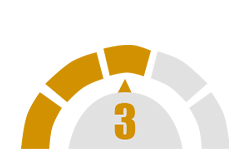
DIFFICULTY LEVEL
Average

